Feature
Army Ants and Their Guests
Learning From the Miniature Societies of Army Ants as a Model for Understanding Group Behavior and Natural Selection
Science Scope—April/May 2020 (Volume 43, Issue 8)
By TAMASHI HETTIARACHCHI, VICTORIA M. SCHILLING, TODD CAMPBELL, JANE O’DONNELL, AND JANINE CAIRA
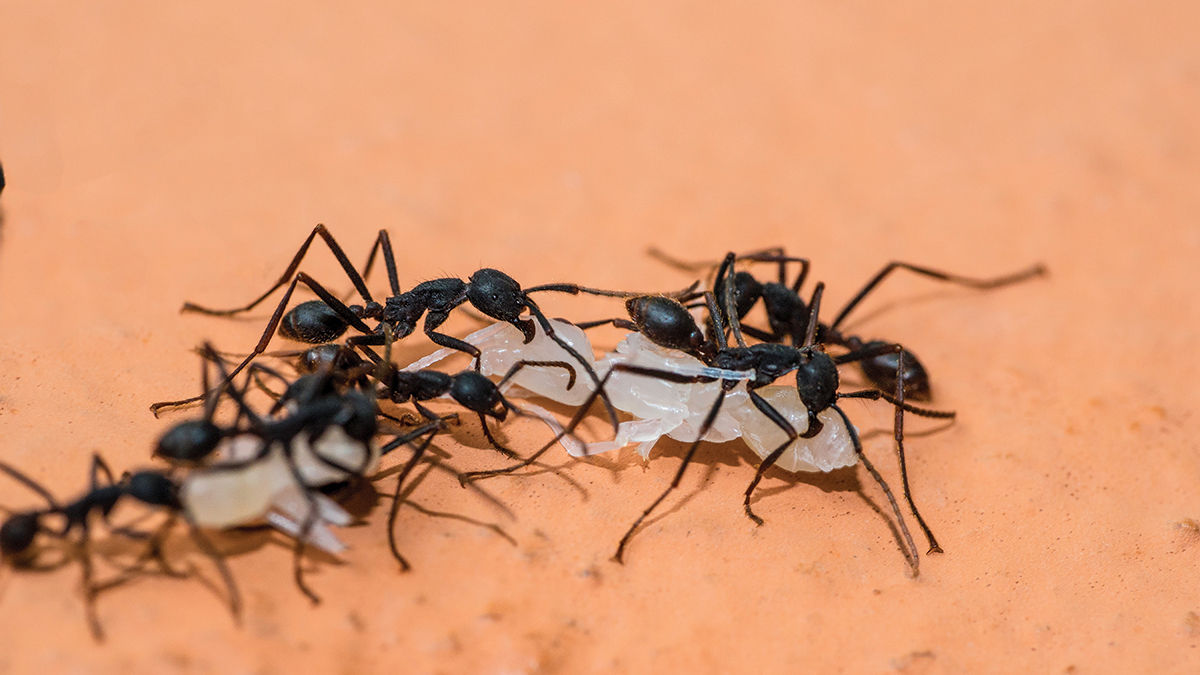
CONTENT AREA Life science
GRADE LEVEL 6–8
BIG IDEA/UNIT
Bend 1: Group Behavior
Bend 2: Natural Selection
ESSENTIAL PRE-EXISTING KNOWLEDGE
Bend 1: Students should understand that reproduction is essential to every kind of organism.
Bend 2: Students should be familiar with genetic concepts including sexual reproduction resulting in off spring with slight variations and should understand that particular organisms can only survive in particular environments.
TIME REQUIRED Ten 45-minute class periods (450 minutes):
Bend 1: Two 45-minute class periods
Bend 2: Eight 45-minute class periods
COST $20 for the optional ant farm, $20 for materials for finches activity. All other content for the unit can be found online at no cost (see Resources).
SAFETY Safety glasses should be worn during the beaks of finches activity
The Carl and Marian Rettenmeyer Army Ant Guest Collection housed at the University of Connecticut (see Resources) provides insight into the miniature society of army ants and their guests. This world-class collection consists of over two million specimens of army ants and their guests (more than 500 species of animals associated with the army ants such as mites, beetles, and birds). While some of associations are opportunistic, more than 300 of these species are reliant on the ant for survival. The Rettenmeyer Collection is the result of 50 years of careful, detailed fieldwork in Central and South America by the Rettenmeyers.
This article focuses on a middle school unit that examined army ant group behavior and how natural selection has shaped the evolution of the guests that are intimately associated with army ants. In sequence, this unit would ideally follow a genetics unit, giving students the background knowledge to build on regarding both asexual and sexual reproduction, as well as the mechanisms for offspring inheriting variations in genetic traits.
In this unit students develop and use models to help construct explanations about army ant society behavior and how natural selection has shaped the evolution of army ant guests. Students engage in science and engineering practices to make sense of real-world phenomena. Two practices in particular (i.e., modeling and explanation) were emphasized because researchers such as Windschitl and Calabrese-Barton (2016) noted that although there are many practices, “two appear to be at the heart of disciplinary work—modeling and explanation” (p. 1107). They also pointed out how different domains in science have “their own questions, methods, and standards for evidence, but they are all engaged in the same core pursuit—the development of coherent and comprehensive explanations of the natural world” (p. 1107).
The unit comprises two bends. A bend is a set of lessons intended to support students in developing explanations of the specific anchoring phenomenon that is the focus of the bend. When combined, the two bends (i.e., group behavior and natural selection) help students better understand army ant societies and their guests (see Table 1 in Online Supplemental Materials). The first bend focuses on investigating group behavior as it relates to army ants and other organisms that exhibit group behavior. The second bend focuses on natural selection as it relates to army ant guests and how they evolved to take advantage of army ant societies, along with other examples of natural selection.
In this article, each bend is described before student-developed artifacts (e.g., models, questions) are shared. See Resources for link to the complete curriculum unit and all necessary resources (e.g., student-facing slide show with teacher notes, student activity sheets, 3D assessments). To increase students’ engagement in the unit, we found it beneficial to have ants present in the classroom. This could include a tray of pinned ants from a local university or an inexpensive ant farm purchased for the classroom prior to beginning the unit.
Bend 1: Group behavior
To begin this unit, the teachers shared the phenomenon of army ants working together to achieve a common goal through a series of astonishing videos. As students watched the videos, the teacher prompted students to record their initial observations and any questions they had (see links to handouts in Table 1 and video links in Table 2 in Online Supplemental Materials). These videos engaged students by showing small ants working together to take down a (comparatively) large lizard; displaying ants living together in very small spaces and coordinating with one another to build bridges out of their bodies; and demonstrating how certain army ants have specific roles within the colony that coincide with the essential duties of the colony.
Using their observations and ideas about the army ants in the videos, students in groups of two to three developed an initial model on large chart paper to explain why the ants may be exhibiting these behaviors (see Figure 1). As student groups shared their models with the class, many groups repeated and expanded on the main idea: Ants engage in this behavior for survival, and ants are stronger when working together. Once the class came to consensus about why ants were engaging in these behaviors, students worked with their group to brainstorm and describe related phenomena (i.e., other organisms that live and work as a group for survival; see Figure 1). By considering related phenomena, students could better understand that the group behavior of the army ants can also be observed in many other types of organisms that live in groups. Students were able to recognize how these same concepts (e.g., specialized roles in societies) play an important role in explaining related phenomena groups other than army ants (e.g., bees, birds). Brainstorming about related phenomena can be instrumental for supporting deep connections between familiar ideas and the new things students are observing. Additionally, brainstorming helps students connect what they are learning in classrooms to their lives, communities, and existing ways of thinking (Model-Based Inquiry 2018).
Initial model for natural selection
To help students make connections between Bend 1 (group behavior) and Bend 2 (natural selection), the teacher asked them to discuss why bird watchers may look for swarms of army ants when trying to find birds, building off students’ prior discussions of animal group behaviors. Students watched a video of the relationship between army ants and their antbird guests, which eat prey fleeing from advancing columns of army ants (see link to antbird video in Table 2 in Online Supplemental Materials). The teacher used the Army Ant Guests 1 and 2 sections of the video to introduce the idea of guests in general (see Table 2 in Online Supplemental Materials). Following this, the teacher showed students an image of a bird in the mouth of a crocodile and asked what kind of relationship could be inferred from the picture. The teacher introduced another type of guest of army ants using an image of a beetle that greatly resembles an army ant (see Figure 2). This phenomenon, that one organism could resemble another, was the focus of Bend 2.
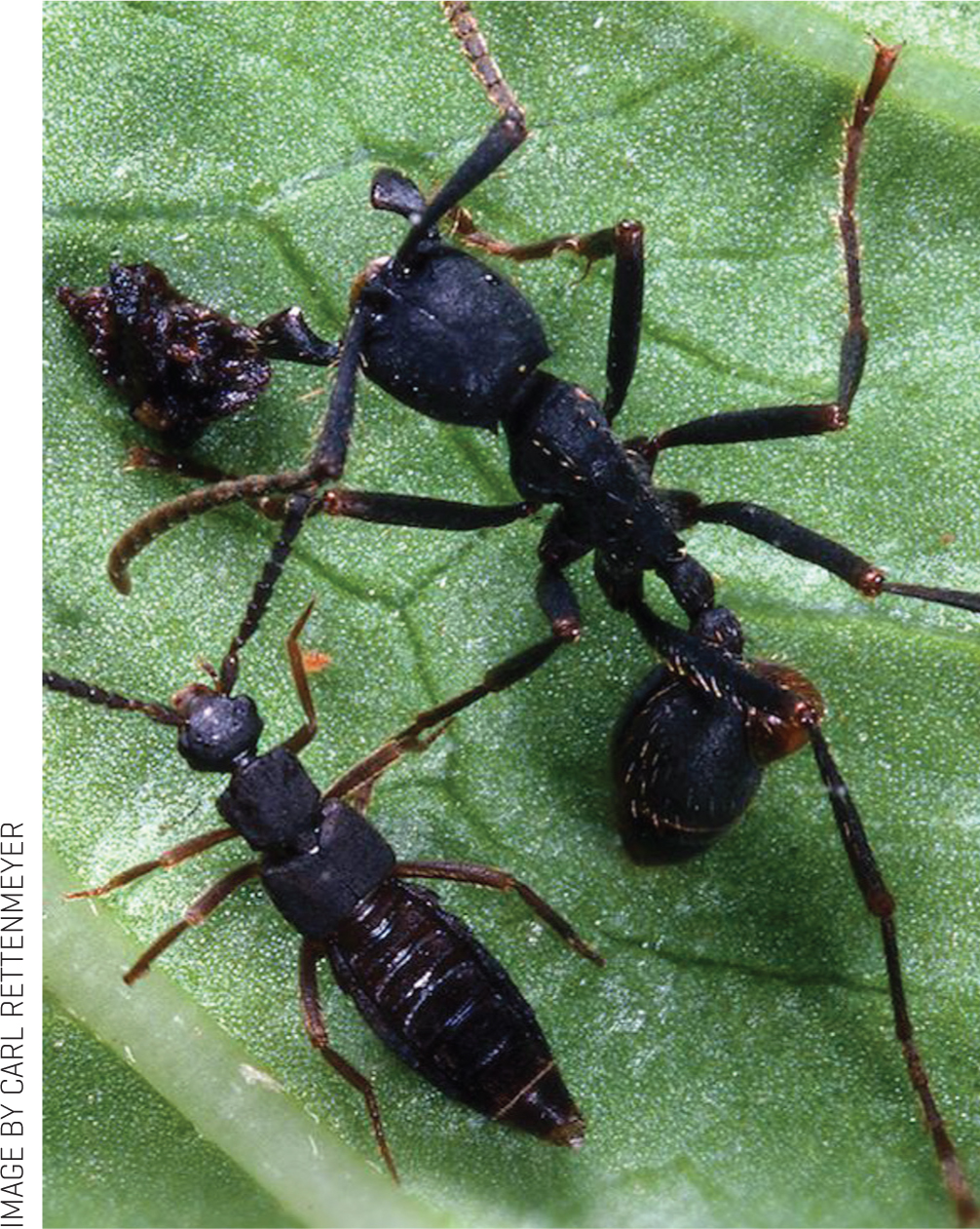
Beetle that resembles army ant
Working in groups of two to three, students used chart paper to create an initial explanatory model (see Figure 3) that explained how this beetle might have come to resemble an army ant. This provided the teacher with an opportunity to determine what prior knowledge students were accessing so that the teacher could tailor instruction in response to students’ initial ideas. Students then shared their initial models with the whole class, which supported learning from and working with others. Students’ initial ideas included an army ant mating with a beetle and having hybrid offspring, or beetles changing across their life span to look more like the ants because it helped them survive.
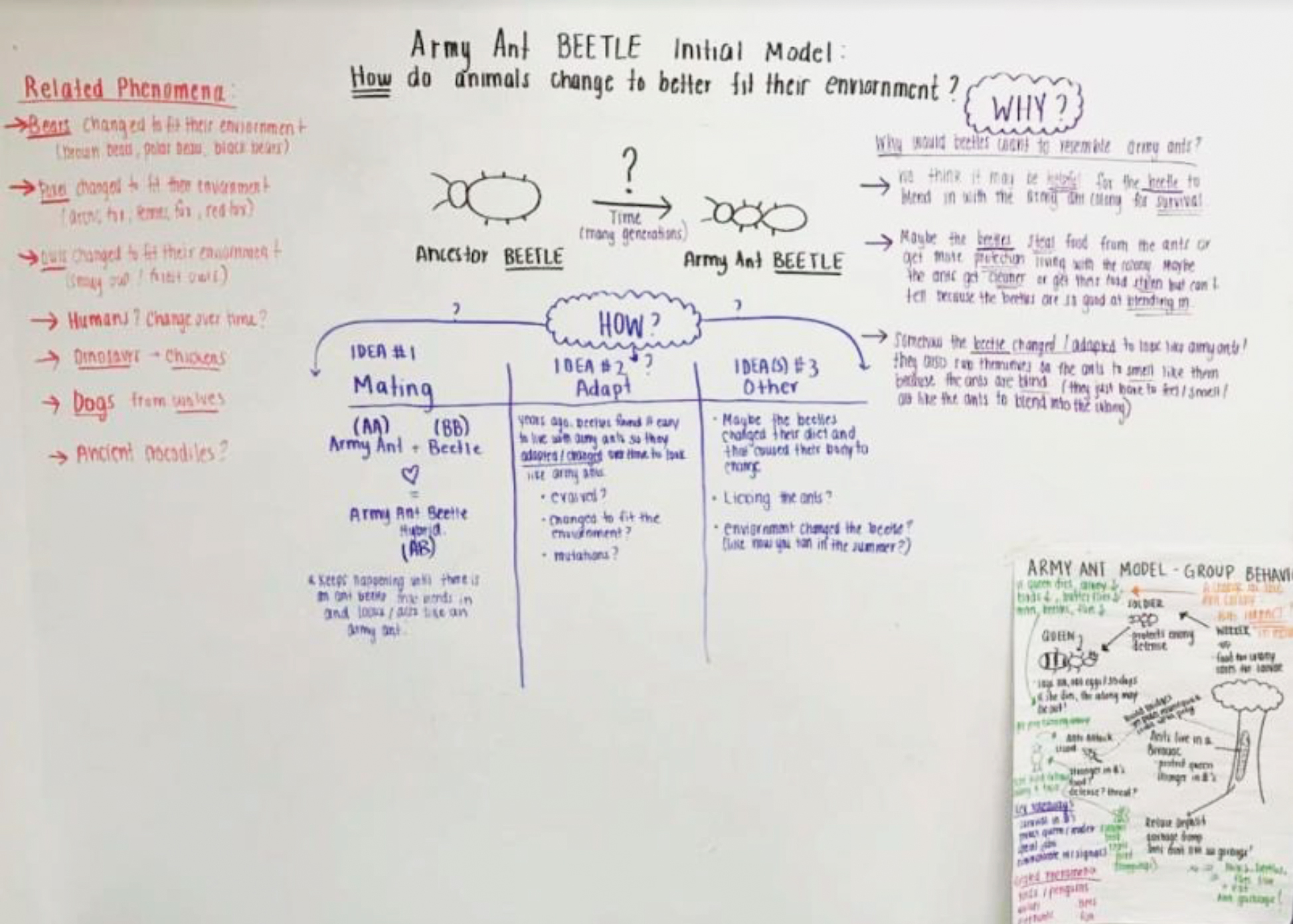
Student initial model for natural selection with brainstormed related phenomena
Learning activities
Throughout the three Bend 2 learning activities described next, teachers emphasized the importance of productive discussion when trying to reason through student ideas and experiences to make connections between activities and phenomena. Here, productive discussion is characterized by students sharing and working on refining their ideas together. When students are engaged in productive discussion, teachers can expect to hear students sharing their initial early draft thinking, before peers ask them to share more or build on what has been shared.
Chicken genetics simulation (see Resources). After developing and sharing their initial models, students used a chicken genetics simulation to review what they had previously learned about genetics and how traits are inherited. Class discussion focused on major principles, including the fact that the offspring of chickens look similar to their parents but have other traits that vary in appearance. (Note: Students in the grade 8 classroom in which this unit was implemented had previously learned how animals reproduce sexually and have offspring with slight genetic variations.) Students related this information back to the army ant phenomenon (i.e., explaining how the beetle came to look so similar to an army ant). Students noticed that the ants in the colony are all slightly different from each other (i.e., soldiers are larger with different body parts for protecting the colony compared with worker ants), similar to the chickens in the simulation.
As a result of the simulation and subsequent class discussion, some students recognized that beetles could also have offspring with varying traits. Many students thought that mating between the army ants and the beetles was responsible for how the beetle’s appearance came to resemble that of an army ant. However, after watching a video explaining the complex fertilization process of army ants, students realized that an ant mating with a beetle was not possible. As evidenced when students in whole-class discussion helped complete a row of the class summary table at the end of each activity, this learning activity supported students in recognizing that organisms produce offspring with small variations in appearance. Here, a summary table is a public representation that students complete in a whole-class discussion with the teacher so that they connect and represent the question the activity helped answer, the activity they engaged in, what they figured out, how it related to the phenomenon, and what new questions emerged as a result of engaging in each activity (see complete curriculum unit provided in Resources for an example unit summary table). They also learned that while cross-species mating is possible, it is limited and rarely leads to offspring capable of reproduction. Students build on these ideas in the next activity.
Peppered moth simulation (see Resources). The second learning activity in this bend was a simulation that used light- and dark-colored peppered moths on a background of light- and dark-colored trees. At the start of this activity, students learned that it has been well-documented that the percentage of light- and dark-colored moths in a population has changed over time. They also learned that examining the mechanism that led to these changes might provide insight into how the beetle’s appearance may have come to resemble that of the army ant.
As an introduction to the activity, students received background information about peppered moths (see link to student handout in Table 1 in Online Supplemental Materials). This information detailed how a larger percentage of light-colored peppered moths existed in the moth population prior to the industrial revolution. However, after the industrial revolution, a larger percentage of dark-colored peppered moths existed. Through this activity, students learned how variation in moth color could lead to a change in the proportion of light- and dark-colored moths in the population over time, depending on which moth color provided a better chance of survival in a given environment. Many students thought that, like the ant-resembling beetle, individual moths had to change to survive in their environment. In this activity, it is evident to students that if a colored moth did not blend in with its environment, it was eaten since no mechanism for an individual to change its appearance existed. This simulation helped students focus more on the shifts from light- to dark-colored moths across the population based on which color was found to be most advantageous (i.e., blending in to avoid predators), instead of shifts in the color of individual moths over their lives. The peppered moth simulation prepared students to think more about populations changing over time and to consider the role of reproduction in those changes while doing the beaks of finches activity.
Beaks of finches activity (see Resources). The third activity in this bend provided students with an interactive experience with the theory of natural selection. Students acted as birds, using tools to simulate beaks of various shapes to collect different kinds of foods. Throughout this activity, students realized that birds with some types of beaks were better at acquiring certain food items than those with other types of beaks. Birds with beaks that were able to collect more food survived and reproduced, whereas those with beaks that were less effective at collecting food died before reproducing. This led to a change in beak type in the population over time, similar to what was seen with the moths in the last activity. In this activity, environmental pressures, such as competition for food resources, select for advantageous traits. Discussion questions within this activity supported students in making more connections between the role of variation and reproduction in populations, especially in relation to environmental pressures. As an example, students considered what might happen to a population of birds during a drought that led to a dramatic change in the availability of different types of food sources. Students considered connections between extinction and species inability to adapt sufficiently quickly to respond to a changing environment, as well as the importance of sexual reproduction and random genetic mutations to species survival.
Revised models
Students used their revised understanding of natural selection—resulting from the three learning activities and simulations—and applied them to refine their initial model of how the beetle came to resemble the army ant (see Figure 4). Through this experience, students understood more about the mechanisms of natural selection and how nature selected for certain favorable traits within a population. Students realized how, over time, traits of the beetle came to resemble traits of an army ant and were thus beneficial for the survival of the beetle, especially in relation to how the beetles that did not blend in with the army ant society were killed by the ants (see Figure 4). This environmental pressure ultimately led to the appearance of the beetles mimicking that of the army ant. (Note: Army ants are actually blind. As a consequence, the resemblance is likely to be a result of tactile and chemical signals.) Some students struggled to integrate their ideas into their final models, even when provided with resources such as a class Gotta Have checklist. Here, a Gotta Have checklist is a teacher–student negotiated set of scientific ideas or relations the class has identified as a result of their investigations across the unit that need to be considered in explaining the phenomenon. The Gotta Have checklist for Bend 2 (Figure 5) was negotiated prior to students developing their final models and served as an additional support alongside the summary table for each group to reference as they completed their final group models to explain the phenomenon. These students had a hard time organizing their ideas on paper. However, they were able to verbally explain their ideas to the teacher and the class. In the future, for students experiencing such struggles, it may be helpful to provide additional scaffolds, such as main ideas from the Gotta Have list, to support them in organizing their model, as well as images and examples from in-class activities.
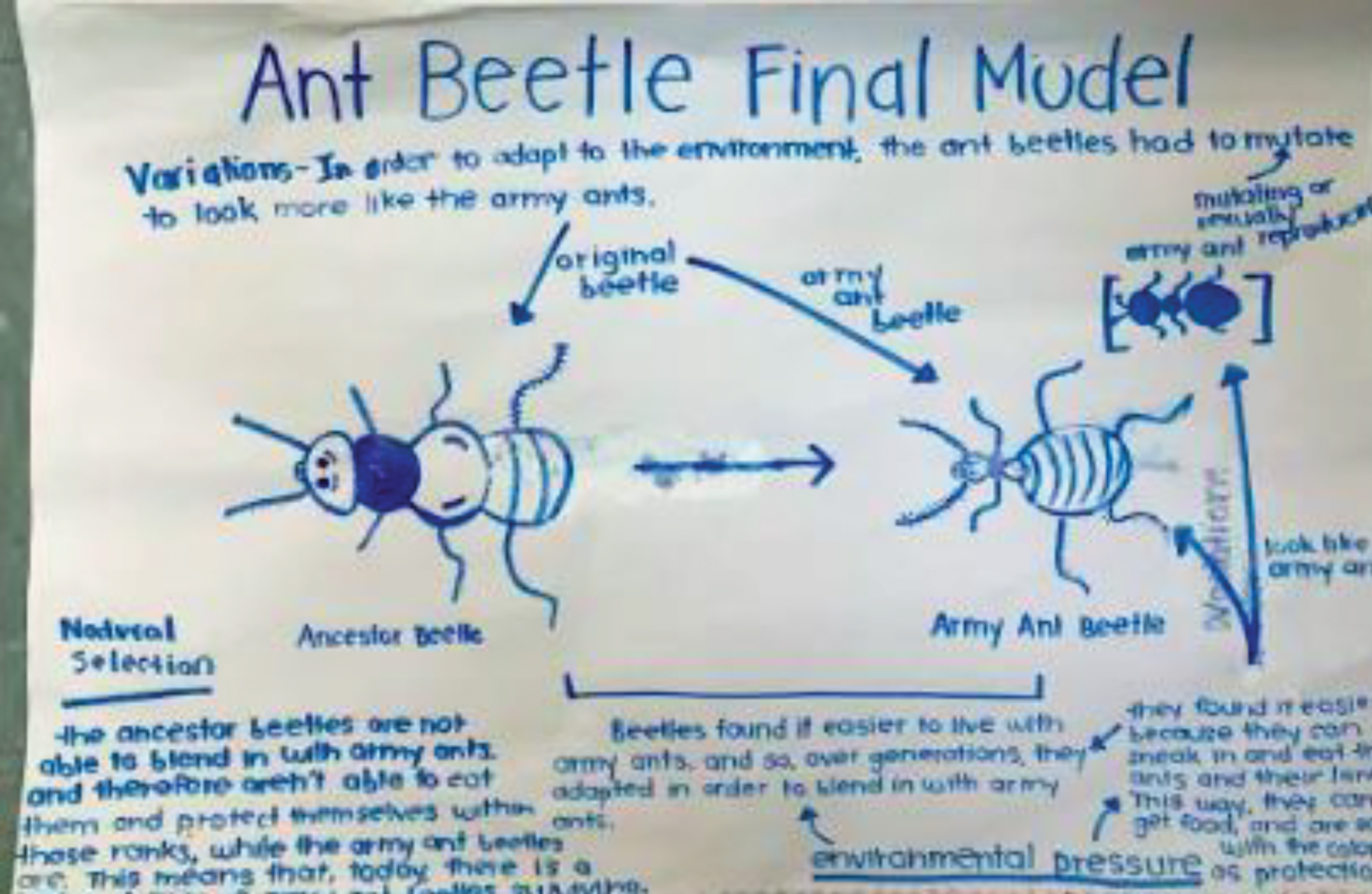
Student revised model for natural selection
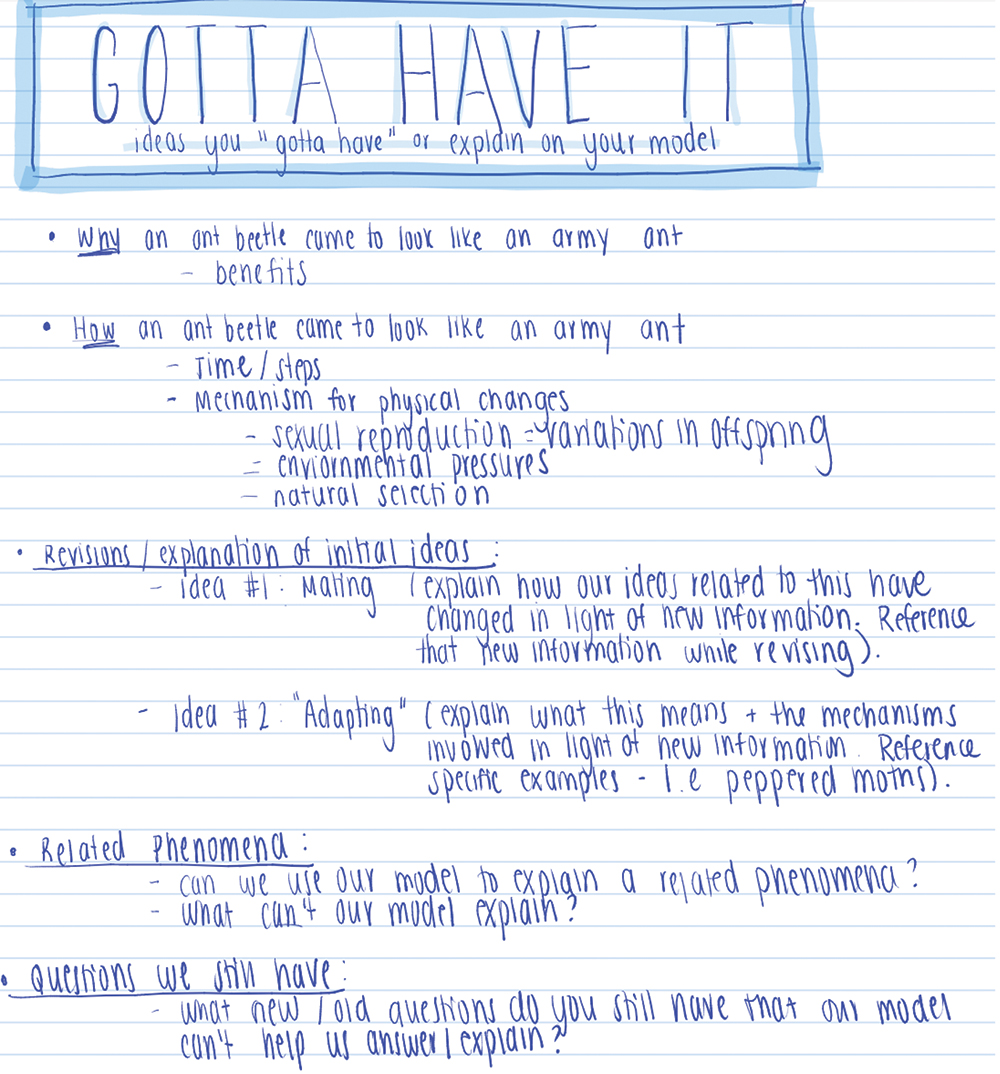
Gotta Have checklist for Bend 2
After completing the final model (see Figure 4) in their original groups, students applied the ideas in their revised model to another example of mimicry in which a mite resembles an army ant larva. Students discussed how this might be possible and why it would be beneficial for the mite to resemble an army ant larva. Some typical responses students shared focused on how the mite looking like the ant larva allowed it to benefit from the close proximity to the ants. More specifically, some students suggested that the mites could possibly benefit by feeding off of the ants like a parasite or from the rich food resources gathered by the ants. Students also thought that the mite might save energy when carried by the army ant.
Assessment: Group behavior and natural selection
Formative assessments throughout this unit included initial models, revised models, group and class discussions, as well as group final models. For example, as the teacher assessed group final models, it became apparent that the final models of some groups did not include all of the ideas from the final Gotta Have list. Group final models also served as a tool to help the teacher better understand the extent to which students engaged in, and understood, the key concepts of the unit and whether additional support and opportunities for subsequent revisions were needed before students completed the unit summative assessments described next.
Summative assessments were included at the end of the unit, which were developed using guidance from STEM Teaching Tools Practice Briefs 30 and 41 (i.e., integrating science and engineering practices and crosscutting concepts, respectively, into assessments; see Resources and note at end of article). In these summative assessments, students answered questions that required them to apply their understanding of group behavior and natural selection to new tasks, scenarios, and phenomena.
Last, the teacher used exit tickets to solicit feedback from students to help better understand their experiences engaging in the unit. Overwhelmingly, student comments were positive. One student said, “I liked how during this unit there were many activities. I also liked how it didn’t just follow the army ants or the ant beetles but instead branched off into other similar phenomena.” Another student shared, “Through these investigations I honestly have more respect for ants because they have a lot of hard jobs to fulfill throughout their lifetime. Their lives are a lot more complicated than I thought they were so I’m just amazed at what they can do.”
Conclusion
This article focuses on a middle school unit that examines army ant society group behavior, as well as how natural selection has shaped the evolution of the guests (e.g., beetles and mites) of army ant societies. Students learned about real-world phenomena using science and engineering practices, especially modeling and explanation, in conjunction with disciplinary ideas and crosscutting concepts to develop and refine their ideas about how and why things happen in the world (see Connecting to the Next Generation Science Standards). In addition, science more generally was presented as a practice of knowledge development through the introduction of powerful ideas that were refined through engaging with peers. Ultimately, we hope this unit, along with the work of Carl and Marian Rettenmeyer and their Army Ant Guest Collection, will provide students and teachers with insight into the complex workings of the miniature society of army ants and their guests.
Note: A STEM Teaching Tool Practice Brief is a two-page brief designed to address a pressing problem of classroom practice. In the case of STEM Teaching Tools 30 and 41, they support teachers in designing assessments that help teachers understand their students’ facility with science and engineering practices and crosscutting concepts, respectively (see link to STEM Teaching Tools in Reources).
Tamashi Hettiarachchi is a chemistry education student, Todd Campbell (todd.campbell@uconn.edu) is a department head and professor in the Department of Curriculum and Instruction, Jane O’Donnell is the collections manager in the Department of Ecology and Evolutionary Biology, and Janine Caira is a professor in the Department of Ecology and Evolutionary Biology, all the University of Connecticut in Storrs. Victoria M. Schilling is an eighth-grade science teacher at Ellington Middle School in Ellington, Connecticut.
ONLINE SUPPLEMENTAL MATERIALS
Table 1: Lesson sequence outline
Table 2: Videos for introducing phenomena
RESOURCES
Complete curriculum unit with student activity sheets and summative assessment
Carl and Marian Rettenmeyer and their Army Ant Guest Collection at the University of Connecticut
Biology Earth & Space Science Labs Middle School


